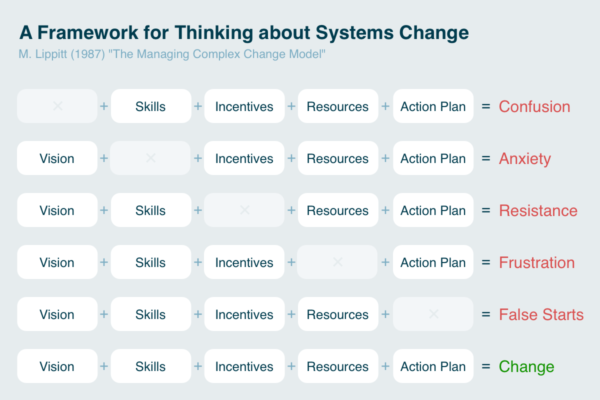Managing change in complex systems such as teams, businesses, and societies can be difficult. That’s why I appreciate when I find solid models that try to provide support in people are working to do these kinds of transformations.
I found the following model referenced in a book about education “Restructuring for Caring and Effective Education: Piecing the Puzzle Together” (2000), referencing an original source by M. Lippitt (1987), “The Managing Complex Change Model”. I wasn’t however able to find the original article. Regardless, the model is very interesting:

This model is in my view useful for two different reasons. The first is that it shows a model to create change based on five different criteria. The other is the kind of outcome that the lack of a specific module can have on the system, which is particularly useful as it allows to backtrack from the issue to the cause of it:
- Confusion → lack of Vision: note that this can be a proper lack of vision, or the lack of understanding of that vision, often due to poor communication and syncrhonization of the people involved.
- Anxiety → lack of Skills: this means that the people involved need to have the ability to do the transformation itself and even more importantly to be skilled enough to thrive once the transformation is completed.
- Resistance → lack of Incentives: incentives are important as people tend to have a big inertia to change, not just for fear generated by the unknown, but also because changing takes energy and as such there needs to be a way to offset that effort.
- Frustration → lack of Resources: sometimes change requires very little in terms of practical resources, but a lot in terms of time of the individuals involved (i.e. to learn a new way to do things), lacking resources will make progress very slow and it’s very frustrating to see that everything is aligned and ready, but doesn’t progress.
- False Starts → lack of Action Plan: action plans don’t have to be too complicated, as small transformative changes can be done with little structure, yet, structure has to be there. For example it’s very useful to have one person to lead the charge, and everyone else agreeing they are the right person to make things happen.
In my current reading I also appreciate that the model doesn’t require all of the components, implying failure in the case of one piece missing. As often happens, change is still possible – it’s just harder. You have to consider the negative effect that comes out of it, and address it.
Thanks to Lorraine Telford (Alberta Health Services) for more details on the original source.